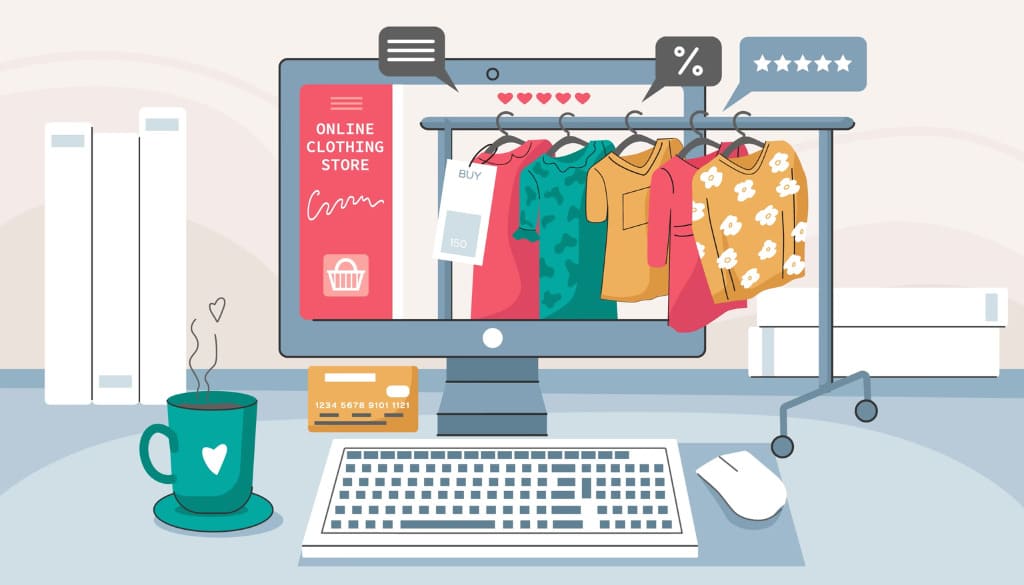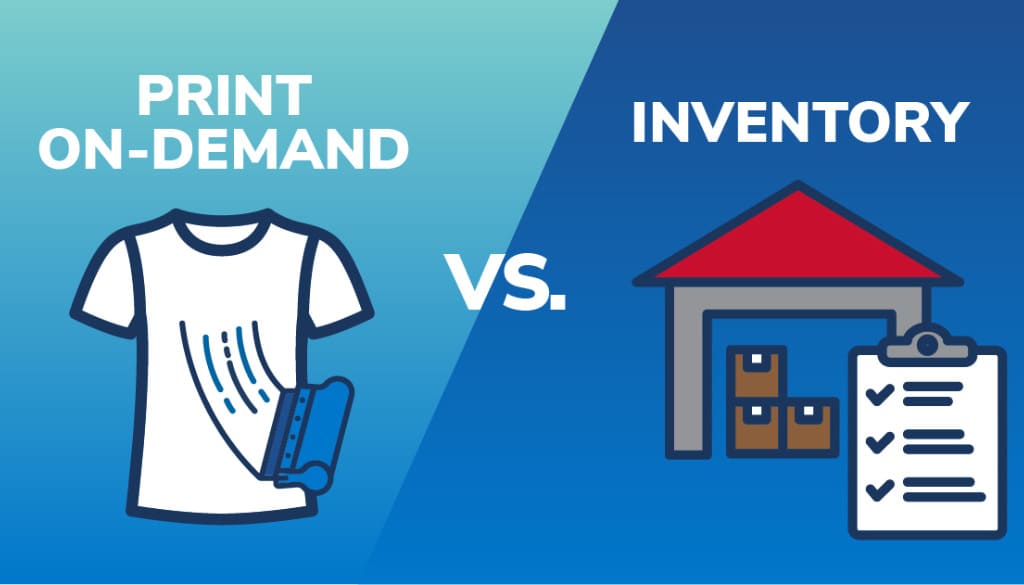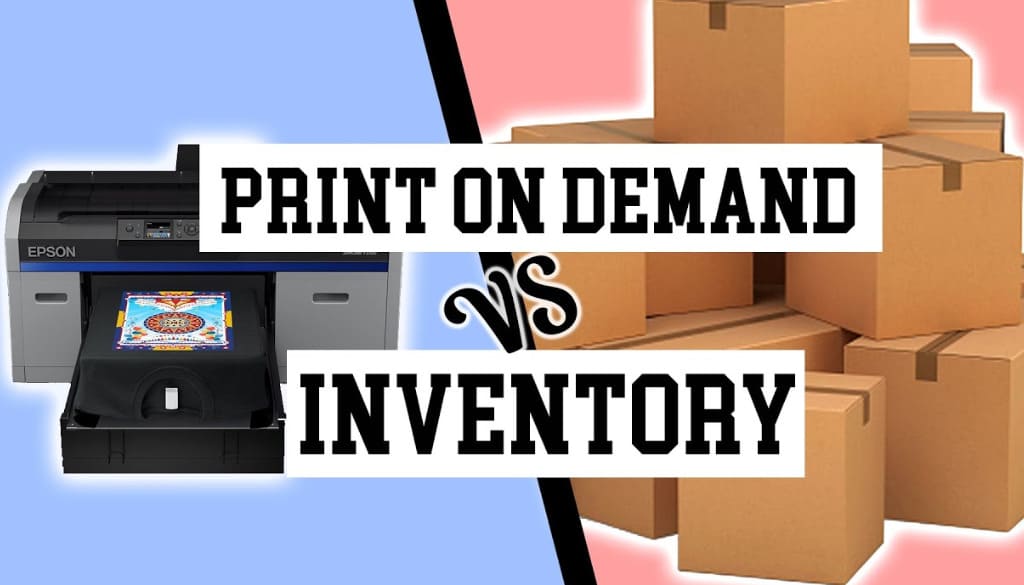In online business, choosing the right sales model is like selecting the “survival strategy” for your store. Many sellers often find themselves torn between two popular approaches: Print on Demand vs. inventory-based selling. Each model comes with its own advantages and drawbacks, directly impacting your profits, scalability, and overall operations. This article will break down both options clearly, helping you make the smartest decision for your e-commerce journey.
What is Print on Demand?

Print on Demand (POD) is a modern e-commerce business model where products are only produced after a customer places an order. Instead of purchasing inventory upfront, storing stock, and waiting for sales, sellers simply create product designs such as t-shirts, hoodies, mugs, canvas prints, or accessories and list them on platforms like Etsy, Amazon, Shopify, or TikTok Shop.
When an order is placed, the system automatically sends the details to a production partner the fulfillment provider. This partner handles printing the design, packaging the item, and shipping it directly to the end customer.
The key advantage of the POD model is that there’s no need to hold inventory, manage warehouses, or worry about stock control, which significantly reduces financial risks for sellers. It allows entrepreneurs to start a business with low upfront costs while giving them the freedom to create personalized and unique designs.
However, the main drawback of POD is the reliance on fulfillment partners, as product quality and delivery speed are determined by third parties. This is an important factor sellers must carefully consider when deciding whether POD is the right business model for them.
What is Inventory-Based Selling?
Inventory-based selling is one of the most traditional and familiar e-commerce models. You purchase or produce products in bulk, store them in your own warehouse (or a third-party warehouse), and when a customer places an order, you or a service provider pick, pack, and ship the items to the buyer.
In other words, you buy first and sell later. You fully own the products and are 100% responsible for managing your entire inventory.
How the Inventory Model Works
- 1. Research & Product Selection – Conduct market research to identify potential best-sellers.
- 2. Manufacturing / Bulk Purchasing – Find suppliers, negotiate prices, and place large production or bulk purchase orders (MOQ – Minimum Order Quantity).
- 3. Warehousing – Store products in your own warehouse, at home, or in a third-party fulfillment center like FlashShip.
- 4. Marketing & Sales – Build your online store, take product photos, write descriptions, and run marketing campaigns.
- 5. Order Processing – Once an order is placed, you (or your team, or a fulfillment provider) will pick, inspect, and package the product.
- 6. Shipping – Connect with logistics providers to deliver products to customers quickly.
- 7. Post-Sales Management – Handle returns, warranties, and customer support.
Advantages of Inventory-Based Selling

If POD offers a safer, low-risk approach, the inventory model is the path for sellers who aim to build a true e-commerce empire.
- Significantly Higher Profit Margins: This is the biggest competitive advantage. By producing or purchasing in bulk, your cost per unit decreases thanks to economies of scale. Higher margins give you more budget for marketing, reinvestment, and competitive pricing.
- Complete Control Over Operations: You’re the captain of your ship. From sourcing and quality control to packaging and shipping, everything is under your supervision.
- Better Product Quality: You can personally inspect and QC every item before storing it and before shipping to customers, ensuring top-notch quality.
- Full Control Over Brand Experience: You get to decide exactly how your brand is presented to customers from custom-branded packaging and personalized thank-you cards to premium unboxing experiences and small surprise gifts. This creates a memorable, high-end brand identity.
- Real-Time Inventory Management: By knowing exactly how much stock you have, you can better plan for large-scale marketing campaigns, seasonal promotions, and restocking strategies.
- Faster Shipping Times: With products readily available in your warehouse, you can process and hand off orders to couriers the same day. This speed can significantly boost conversion rates and customer satisfaction.
- Stronger Supplier Relationships: Placing large bulk orders allows you to negotiate better pricing, secure favorable payment terms, and even collaborate on exclusive product development with your manufacturers.
Disadvantages of Inventory-Based Selling
Of course, greater control comes with greater responsibility and risk.
High Upfront Investment
You need a substantial initial budget to purchase your first bulk order. Depending on the product and volume, this could range from thousands to hundreds of thousands of dollars — a significant barrier for beginners.
Risk of Unsold Inventory & Tied-Up Capital
If products don’t sell as expected, your capital gets locked up in unsold stock. In many cases, sellers are forced to heavily discount products just to recover part of their investment.
Complex Logistics Management
Managing inventory comes with multiple operational challenges:
- Warehousing: You need adequate storage space. For home-based sellers, living spaces can quickly turn into mini warehouses. If you rent a separate warehouse, costs increase.
- Inventory Control: You’ll need proper systems to track stock levels, manage inbound/outbound goods, and optimize storage layouts for faster fulfillment.
- Packaging & Shipping: Packing hundreds of orders daily is time-consuming and prone to errors if not managed properly.
- Staffing Costs: As your business scales, you’ll likely need to hire warehouse staff, pickers, and packers, increasing operational expenses.
The Role of Fulfillment Services
Because of these logistical challenges, many sellers turn to third-party fulfillment providers like FlashShip. These services handle warehousing, packaging, and shipping on your behalf, enabling you to enjoy the advantages of inventory-based selling without the headaches of managing logistics yourself.

Comparison Between Print on Demand vs. Inventory-Based Selling
To better understand the key differences, let’s compare these two business models based on the most important criteria for sellers:
|
Criteria |
Print on Demand (POD) |
Inventory-Based Selling |
|
Initial Investment |
Very low / Almost zero. You only need to cover design and marketing costs. |
Very high. Requires significant capital to produce or purchase the first bulk order. |
|
Financial Risk |
Minimal. If products don’t sell, there’s no loss on inventory. |
High. Risk of unsold stock, tied-up capital, and outdated products. |
|
Profit Margins |
Lower. Per-unit production costs are higher. |
Higher. Economies of scale reduce the cost per unit, increasing overall margins. |
|
Shipping Speed |
Slower. Production time (2–7 days) is required before shipping. |
Faster. Products are ready in stock and can be shipped the same day. |
|
Quality Control |
Limited. You rely entirely on the POD provider’s quality. |
Full control. You can personally inspect products before storage and delivery. |
|
Brand Building |
Challenging. Limited customization options for packaging and unboxing experiences. |
Ideal. Full control to create a premium, unique, and memorable brand experience. |
|
Product Variety |
Extremely flexible. Easy to offer hundreds of different designs and products. |
Limited. Restricted by available capital and storage space. |
|
Operational Complexity |
Simple. Most logistics and fulfillment processes are automated by the POD partner. |
Complex. Requires expertise in warehouse management, staffing, operations, and cash flow control. |
|
Best Suited For |
Beginners, creators, side hustlers, businesses testing new products, and large brands expanding into cross-border e-commerce. |
Established businesses with proven products, aiming to maximize profit margins and build a strong brand presence. |
Similarly, you can explore the differences between Print on Demand vs Dropshipping, including their advantages, disadvantages, operations, and suggestions for choosing the right model for your business goals.
Which Model Should You Choose?
There’s no absolute “right” or “wrong” answer here. The best business model is the one that fits your current situation and long-term goals. Ask yourself the following questions before deciding:
Choose POD if you are:
- A complete beginner (newbie): You have little to no experience in e-commerce and want to learn and experiment with minimal risk.
- On a tight budget: You don’t have or don’t want to risk a large upfront investment.
- An artist, designer, or content creator (KOL/KOC): Your strength lies in creativity and community building. POD allows you to monetize your designs or personal brand without worrying about production and logistics.
- Selling trend-driven products: For products with short life cycles, POD lets you quickly catch trends without the risk of being stuck with unsold stock when the trend fades.
- Testing a new niche market: Before making a large investment in bulk inventory, POD helps you test demand and collect market feedback safely.
Choose Inventory-Based Selling if you are:
- Confident in a “winning product”: You’ve already tested the market (possibly using POD or other methods) and confirmed strong demand for your product.
- Focused on maximizing profit margins: You’re ready to invest in bulk production to reduce costs per unit and increase overall profits.
- Serious about brand building: You want customers to remember your business, not just for the products but also for the premium shopping experience — from fast shipping to beautiful, custom packaging.
- Selling products that require strict quality control: For items like cosmetics, supplements, or electronics, maintaining consistent product quality is critical.
- Ready to scale up: Your business has moved beyond the early testing phase, and you’re ready to build a professional, scalable operational system to handle increasing order volumes.
The Third Path: The Hybrid Model – A Smart Seller’s Choice

Why choose one when you can leverage the strengths of both? Many successful sellers are adopting a hybrid model that combines POD and inventory-based selling.
How the Hybrid Model Works:
Phase 1: Test with POD
Use POD to launch multiple designs or products quickly. This is your playground for experimentation, you can gather data, measure customer interest, and get valuable feedback without financial risk.
Phase 2: Analyze and Select Best-Sellers
After some time, identify which products or designs become consistent best-sellers that generate stable revenue.
Phase 3: Scale with Inventory
For these best-selling products, switch to bulk production and adopt the inventory model. This allows you to:
- Boost profit margins on your top-performing products.
- Offer faster shipping speeds for hot-selling items, increasing customer satisfaction.
- Gain greater control over quality for your most important products.
Phase 4: Keep Innovating with POD
While scaling your inventory-based products, continue using POD to test new ideas, launch seasonal collections, and keep your catalog diverse.
It’s a scalable, sustainable strategy allowing you to experiment continuously while doubling down on proven products to maximize growth.
Both Print on Demand (POD) and inventory-based selling have their own advantages and drawbacks. Depending on your goals, resources, and strategy, each seller will choose the path that best suits them. Whether you want to start with a low-investment model like POD or maximize profits through inventory-based selling, the key to success is having a trusted fulfillment partner by your side.
Get in touch with FlashShip today for professional fulfillment solutions, comprehensive seller support, and advanced technology to optimize your POD selling experience.
Hotline: (+84) 943 024 337
Website: seller.FlashShip.net
Start your journey to “print every idea” and accelerate your business growth with FlashShip.
Read more articles:

